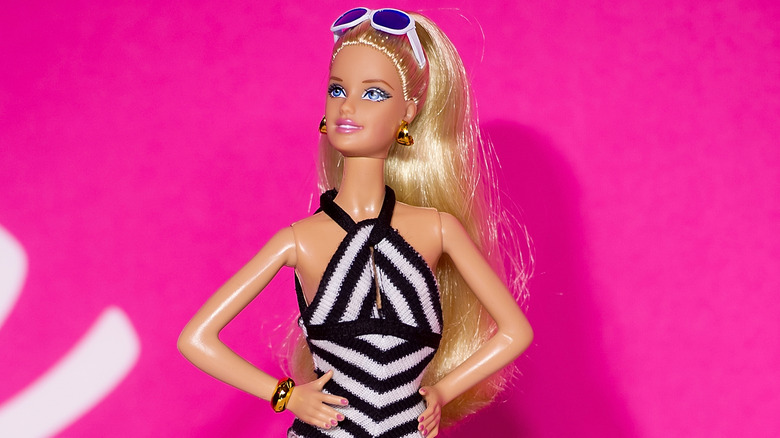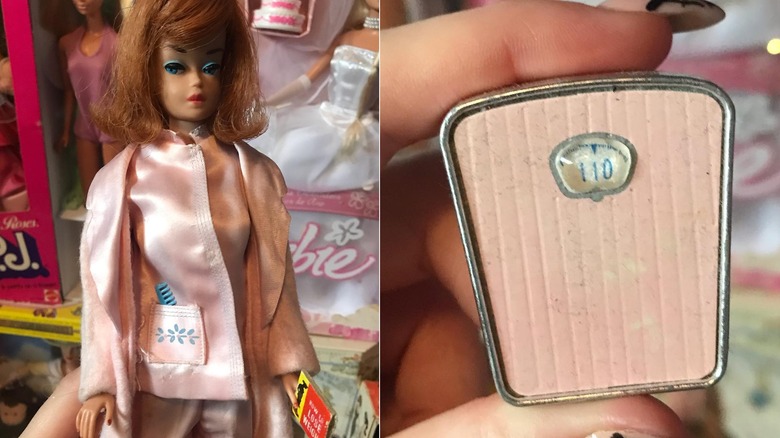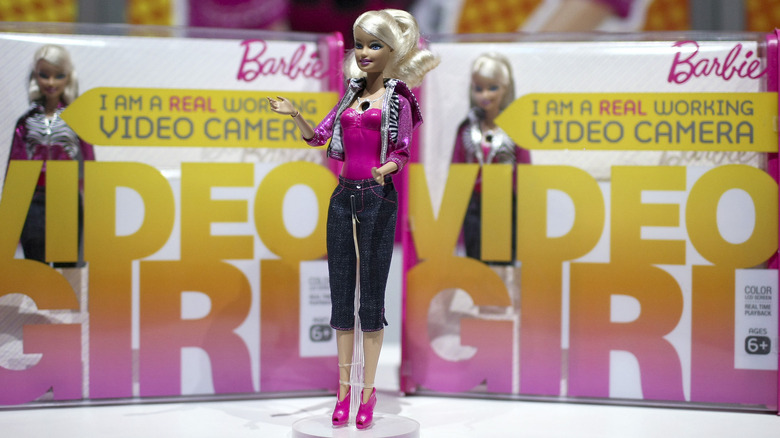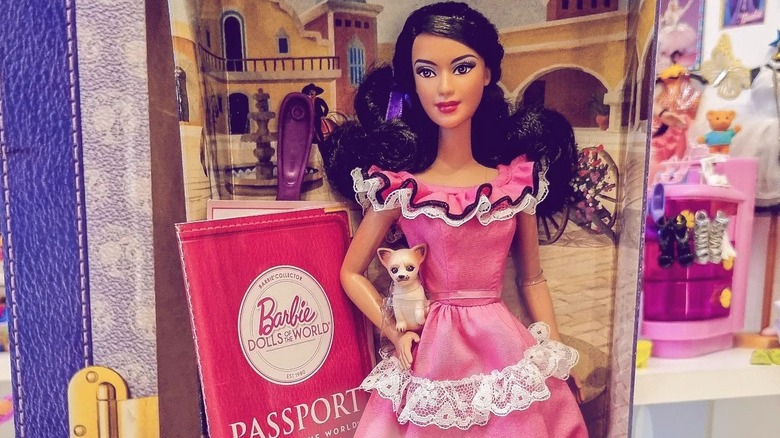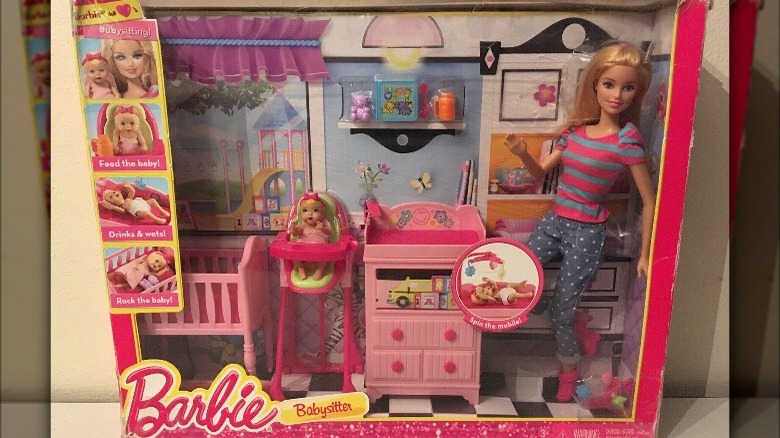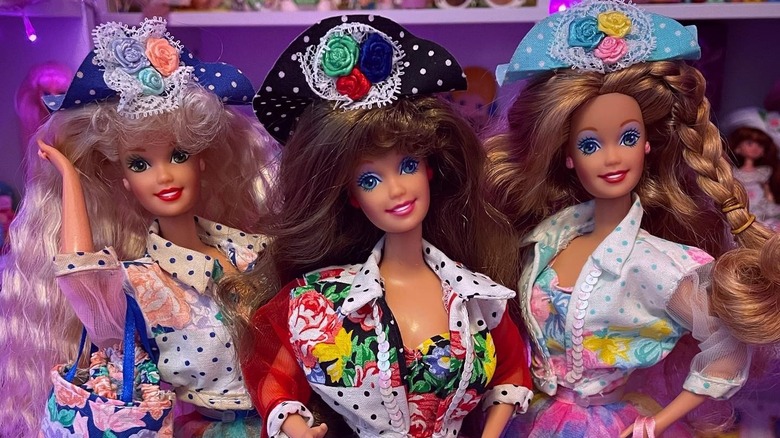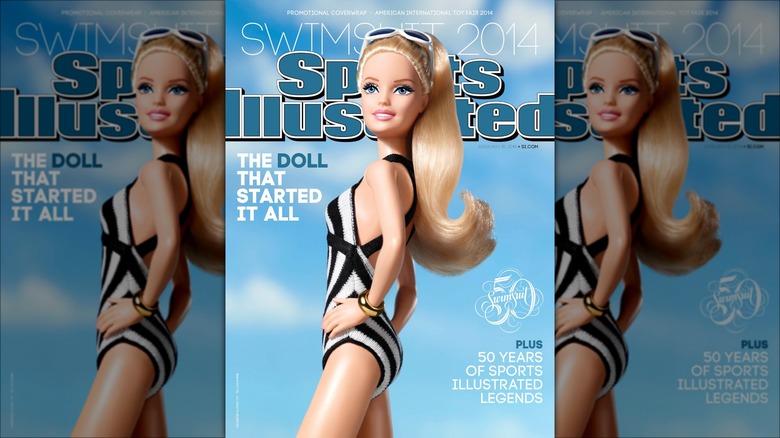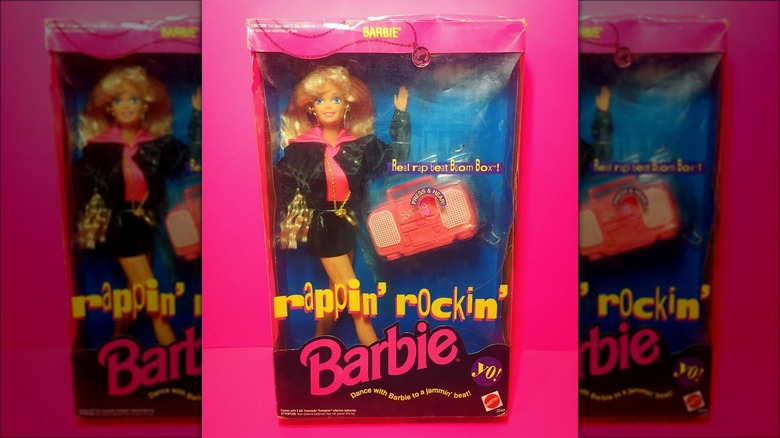You Probably Forgot About These Controversial Barbies
The very first Barbie debuted all the way back in 1959, when creator Ruth Handler introduced the blonde, blue-eyed doll in a black-and-white striped swimsuit. Ruth and her husband Elliot Handler founded Mattel after Ruth came up with the idea for the toy when watching their daughter play with paper dolls. In 1961, the brand released Ken, Barbie's boyfriend, who's served as eye candy and a companion doll. Other dolls, like Barbie's younger sister Skipper, have also been added in subsequent years.
Since the company was founded, Mattel has sold more than a billion Barbies, with different iterations of the dolls enjoying a wide variety of hobbies and careers. The Barbie craze was reignited once again when it was announced that Greta Gerwig would be directing a live-action Barbie movie. Unfortunately, not everything Barbie has been considered a good thing. The brand is no stranger to controversy and has been criticized for missing the mark with a number of dolls.
In 2020, for example, Mattel came under fire for what some considered its "ambiguously Asian" 2020 Tokyo Olympics Barbie. The company eventually owned up to the mistake, saying in a statement provided to NBC News, "Our intention to represent the Asian community with the Skateboarder doll fell short and we fully receive and recognize the feedback." Depending on who you ask, though, this more recent mistake was not the biggest one Mattel has made.
Slumber Party Barbie arrived on the scene with a scale
In 1965, Mattel released a brand new Barbie that the company surely thought would delight children and their parents — Slumber Party Barbie. She arrived adorned in a pink robe and satin pajamas, carrying her own hair and beauty items, like curlers, a blue comb, and bobby pins. Gender-normative, sure, but cute for the time, right? Well, she could have been if Slumber Party Barbie had not also arrived with her very own pink bathroom scale, which was fixed to 110 pounds, and a diet book that looked as if it came straight from a horror museum, titled "How to Lose Weight." The book featured bold instructions for weight loss on the back: "DON'T EAT!" Mattel removed the controversial scale from the set the following year; however, Slumber Party Barbie's guidebook remained.
The doll brings to mind the many objections that the people who love Barbie and people who loathe Barbie have made over the year, primarily having to do with the unrealistic body image ideals the doll seems to promote. In April 2011, HuffPost contributor Gaila Slayen shared a photo of the bizarre mannequin she built for a school project, which was modeled on Barbie's unrealistic body proportions. Slayen wrote, "She stands about six feet tall with a 39" bust, 18" waist, and 33" hips. ... She reminds us of something we once loved, while showing us the absurdity of our obsession with perfection."
Video Girl Barbie could actually record kids while they played
In 2010, an alert from the FBI was erroneously sent to the media. Contained in the alert was a warning that surprised a lot of people because the subject was none other than ... Barbie herself — specifically Video Girl Barbie, which had been released that year. While the name alone might've prompted some worry from parents and caregivers, especially given the rise of "video girls" online, the concern from the FBI was that Video Girl Barbie had an actual camera inside her chest — one that could potentially be used to record kids without their knowledge or consent. However, this alert was not meant to go public.
"The alert's intent was to ensure law enforcement agencies were aware that the doll, like any other video-capable equipment, could contain evidence and to not disregard such an item during a search," the FBI clarified in a statement provided to NBC10 Philadelphia. The FBI stressed that there hadn't been an incident involving the doll and ill intent.
Nevertheless, the doll was enormously popular with kids at the time. As a local Toys-R-Us employee told NBC10, lines of customers showed up to buy the Barbie and they ultimately sold out of the doll. Video Girl Barbie was eventually discontinued, but that hasn't stopped the curious from tracking down the dolls that are still out there.
Mexico Barbie was criticized for being a tired trope
In 2013, Mattel was back in the news after the company released the poorly received Mexico Barbie. Despite the company's attempt to bring more diversity into the fold, Mattel was lambasted for playing into one too many stereotypes when introducing the doll. Mexico Barbie, which was part of the brand's Dolls of the World collection, was described by Mattel as "being dressed for a fabulous fiesta" and came with two accessories — a Chihuahua and a passport.
As Jason Ruiz, a professor of American Studies at Notre Dame University, told ABC News, "It sounds to me like Mattel took some shortcuts. The bright pink ribbons [in her hair]? A Chihuahua? That kind of stuff is so easy to use." He then added that many portrayals of Mexicans and Mexican Americans rely on the same tropes. "[Mexican Americans] are tired of being seen as merely colorful," he said.
Claudya Martinez, staff writer for MamásLatinas, chimed in. While all of the Dolls of the World Barbies carried passports, she reportedly found it "jarring" that Mexico Barbie had one, given the ongoing conversations surrounding emigration from Mexico and Central and South American countries. "If you happen to be one of the cultures who is continuously bombarded with stereotypes, it's hard not to notice that the progress you thought had been made has been taken for granted," Martinez said.
2014's Barbie Babysitter was underwhelming
In 2014, Mattel launched a new doll called Barbie Babysitter. This was the second time the brand had attempted to use the name — and it was about as odd as the first time around. The first Barbie Babysitter debuted in 1963 and came with the same "How to Lose Weight" diet book sold with Slumber Party Barbie.
The second time around, Barbie Babysitter was included as part of a collection about careers. The decision to include a babysitter might not have been that controversial if it hadn't been included with careers like nurse, doctor, ice skater, music teacher, and entrepreneur. In other words, the rest of the jobs were a little more mature.
As pointed out by The Gamer, Mattel could have saved the day by making this Barbie an early childhood education specialist. Barbie could've even managed a daycare — there were a number of options that the brand could have pursued instead.
Oreo Barbie was considered racist and damaging
In 1994, Mattel partnered with Nabisco to create a Barbie doll that could promote both brands in a positive light. The result was Oreo Barbie — a blonde, blue-eyed, white doll dressed in an Oreo-themed blue dress. The doll was enormously popular, and in 2001 Mattel came out with another set of Oreo Barbies. This time around, one of the dolls was Black.
While it can be assumed that the brand had the best intentions with the doll, it's easy to see why this would be offensive. "Oreo" is a well-known derogatory word for a Black person who "acts white," as Instagram user @uptownbill007 explained. The release of the doll is a great example of why it's important to have diverse leadership at all brands.
The doll was immediately met with a wave of disbelief and outrage and was ultimately discontinued. While one might assume that Mattel would never repeat the mistake again, that wasn't the case. Over a decade later the company partnered with Ritz and released — wait for it — Ritz Cracker Barbie, playing into another obvious racial slur.
Teen Talk Barbie played into the stereotype that math is too hard for girls
In 1992, Mattel debuted Teen Talk Barbie. Each doll had a voice box, which was programmed with four of 270 possible phrases. These included a number of phrases that were vaguely problematic, such as, "Let's plan our dream wedding!" and "Will we ever have enough clothes?" but the doll also offered up phrases like "I'm studying to be a doctor."
However, there was one phrase in particular that rubbed a lot of people the wrong way. Some of the Teen Talk Barbies were programmed to complain, "Math class is tough!" Teen Talk Ken, however, uttered no such phrase. Many took issue with this because it perpetuates the idea that girls don't like or aren't good at math. The National Council of Teachers of Mathematics and The American Association of University of Women both ended up issuing complaints about the dolls, according to the book "Good Toys, Bad Toys: How Safety, Society, Politics and Fashion Have Reshaped Children's Playthings."
To make matters worse, as The New York Times reported, a group of performance artists got their hands on Teen Talk Barbie and began swapping out their voice boxes for the ones in G.I. Joes, meaning some kids across two or more states came home with Barbies that wanted to attack opposing military forces instead of, say, go shopping at the mall.
Parents didn't love Sports Illustrated Barbie
Much like Martha Stewart, Barbie is an icon for women all over the world. Also like Martha Stewart, Barbie was hit with some backlash after she graced the cover of Sports Illustrated.
News that Barbie would be on about 1,000 issues of Sports Illustrated, which were to be distributed at the New York Toy Fair, came in 2014 amid reports that Mattel was suffering losses and looking for a way to inject energy (apparently by any means necessary) back into the brand. Barbie posed in the magazine alongside real women for the issue, and a Sports Illustrated edition doll was released. As reported by NBC News, Mattel's spokesperson at the time explained, "Posing in SI gives Barbie and her fellow legends an opportunity to own who they are, celebrate what they have accomplished and show the world it is OK to be capable and captivating."
Sports Illustrated Barbie ruffled some parents' feathers, especially among those who believe that the doll represents unrealistic expectations and standards for body image and size. But it seemed that Mattel was prepared for the potential backlash, as the campaign ran with the hashtag #unapologetic. Sports Illustrated Barbie definitely struck a chord, but not all the feedback was negative. Another Mattel spokesperson explained to Ad Age that the doll, like the magazine itself, is no stranger to controversy and conversation. "As with Barbie, every year the Swimsuit edition sparks conversations about women and body image, and Sports Illustrated stands unapologetically behind this issue that women, in reality, love," the spokesperson said.
Rappin' Rockin' Barbie was wrong on nearly every level
In 1992, Mattel went out on a major limb and released Rappin' Rockin' Barbie. This particular Barbie was introduced along with three of her friends (Teresa, Christie, and Ken), and all four dolls carried their own boom box that even played a beat. It seems clear that Mattel was hoping to make a splash during an era that many consider to be rap and hip hop's finest, but it didn't quite go as planned.
Many of the issues with Rappin' Rockin' Barbie are obvious: the white, blue-eyed doll wears a gold chain, large hoop earrings, and gold rings — all clearly appropriated from a culture that Barbie had not previously appeared to have any experience within. While the doll wasn't taken off the shelves, she definitely left a bad taste in many people's mouths.
At the time, the Los Angeles Times reported that the Barbie was offensive to some. "They're reducing our culture to a fad," one college student told the publication. Walter Allen, a sociology professor at UCLA, added, "That's the dilemma of being black in this society. A situation where you're inside, but you're outside. That position where people scorn you but imitate you."
